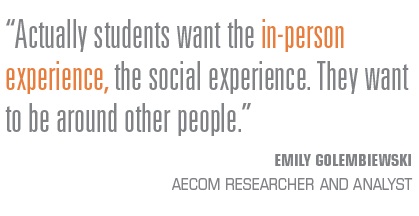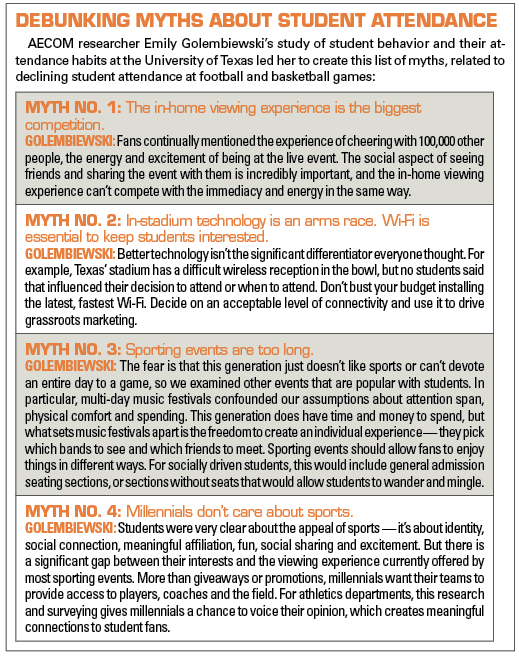While conventional wisdom indicates that connectivity and the at-home viewing experience are primary reasons why fans don’t go to games, an AECOM study of University of Texas students shows that those factors aren’t as important as first thought.
AECOM, an engineering and design firm, surveyed students who attended Longhorns games and those who didn’t attend, to learn from the broadest audience possible. Officials talked to fans at the game and leaving the game, as well as those who watched on TV from a bar and didn’t go at all.
 |
AECOM studied students at the University of Texas.
Photo by: Enter Name Here |
AECOM and Texas athletics partnered on the study due to trends in declining student attendance in college football, which mirror declines in the general fan population.
Overall, college football attendance dropped to an average of 44,190 last season at the Football Bowl Subdivision level, the lowest mark since at least 2003, according to the NCAA’s figures. A 2014 study of 50 top public colleges by The Wall Street Journal showed student attendance down 7 percent since 2009.
These trends have administrators worried about filling seats, selling tickets and generating future donations from the current crop of students who are the boosters of tomorrow.
“To keep college football thriving, we’ve got to meet the demands of our customers,” said Steve Hank, chief revenue officer and senior associate athletic director at Texas. “Students are our bedrock. They provide the energy in the stadium and they are the next generation that’s going to keep this going forward.”
So Texas and AECOM went ahead with the study last football season and presented it to the school over the summer.
The results were so different from previous perceptions that it prompted AECOM researcher and analyst Emily Golembiewski to create a list of the most common myths related to declining attendance (see breakout). She found that the at-home viewing experience and the lack of Wi-Fi at Darrell K Royal-Texas Memorial Stadium weren’t the impediments to attendance once thought.
That’s consistent with findings from another student survey conducted last season by the National Association of
Collegiate Marketing Administrators, which showed that students aren’t necessarily turning against football.
AECOM, which was provided access to 50,000 student records at Texas, determined that the student population is more diverse, more academically oriented and perhaps not as familiar with football. But they still want the social experience of going to the games with their friends.
“No one said they wanted to stay home and watch the game on TV,” Golembiewski said. “If they weren’t at the game, they were going to do something else in Austin. Actually students want the in-person experience, the social experience. They want to be around other people.”
Texas responded to AECOM’s findings with several additions to home football games this season.
In the survey, students asked for places within the stadium to gather that have an Austin feel, so the school created a fan fest for home games in the spacious north end of the stadium. There, the school has injected a bit of Austin with food trucks and other food outlets from Torchy’s Tacos, Pluckers Wing Bar and Austin’s Pizza, which is the fan fest’s presenting sponsor.
This area, accessible to all fans with a game ticket, will open four hours before kickoff as part of a fan fest experience that will include live music from local groups throughout the season.
“It’s an evolving and changing fan base and that’s the students also,” Hank said. “One of the things we heard from students is that they want a place to gather.”
While Texas still has reserved seating in its student section of nearly 17,000 seats, Golembiewski said students want to be able to sit together to promote the social experience, so general admission seating is something that should be considered.
“The next generation of students are all about the experiences of their lives,” AECOM architect Ryan Sickman said. “If you simply ask them if they want to go to the game, the answer almost unanimously was yes. Providing the social interactions to bring them into the stadium and make them want to come back is the next step.”






